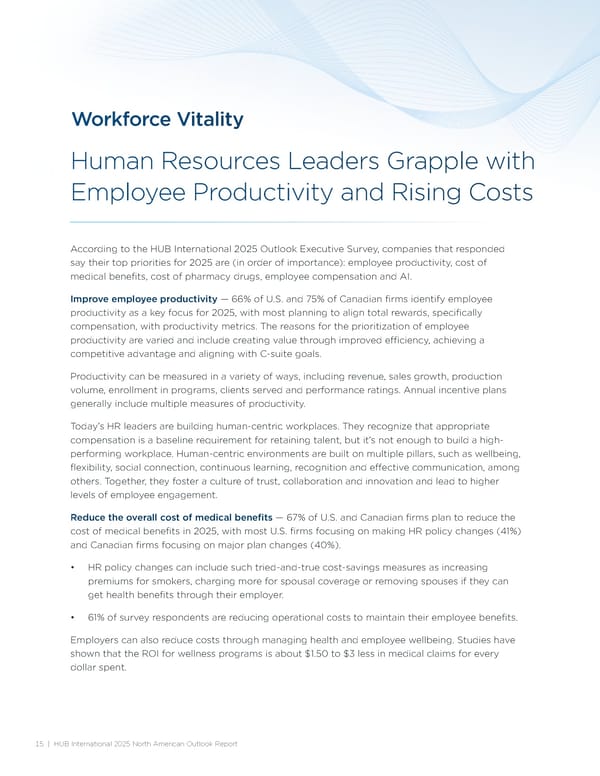Workforce Vitality Human Resources Leaders Grapple with Employee Productivity and Rising Costs According to the HUB International 2025 Outlook Executive Survey, companies that responded say their top priorities for 2025 are (in order of importance): employee productivity, cost of medical benefits, cost of pharmacy drugs, employee compensation and AI. Improve employee productivity — 66% of U.S. and 75% of Canadian firms identify employee productivity as a key focus for 2025, with most planning to align total rewards, specifically compensation, with productivity metrics. The reasons for the prioritization of employee productivity are varied and include creating value through improved efÏciency, achieving a competitive advantage and aligning with C-suite goals. Productivity can be measured in a variety of ways, including revenue, sales growth, production volume, enrollment in programs, clients served and performance ratings. Annual incentive plans generally include multiple measures of productivity. Today’s HR leaders are building human-centric workplaces. They recognize that appropriate compensation is a baseline requirement for retaining talent, but it’s not enough to build a high- performing workplace. Human-centric environments are built on multiple pillars, such as wellbeing, flexibility, social connection, continuous learning, recognition and effective communication, among others. Together, they foster a culture of trust, collaboration and innovation and lead to higher levels of employee engagement. Reduce the overall cost of medical benefits — 67% of U.S. and Canadian firms plan to reduce the cost of medical benefits in 2025, with most U.S. firms focusing on making HR policy changes (41%) and Canadian firms focusing on major plan changes (40%). • HR policy changes can include such tried-and-true cost-savings measures as increasing premiums for smokers, charging more for spousal coverage or removing spouses if they can get health benefits through their employer. • 61% of survey respondents are reducing operational costs to maintain their employee benefits. Employers can also reduce costs through managing health and employee wellbeing. Studies have shown that the ROI for wellness programs is about $1.50 to $3 less in medical claims for every dollar spent. hubinternational.com 15 | HUB International 2025 North American Outlook Report
 Outlook 2025: North American Report Page 14 Page 16
Outlook 2025: North American Report Page 14 Page 16